California’s wildfire threat could be an opportunity for clean-energy microgrids
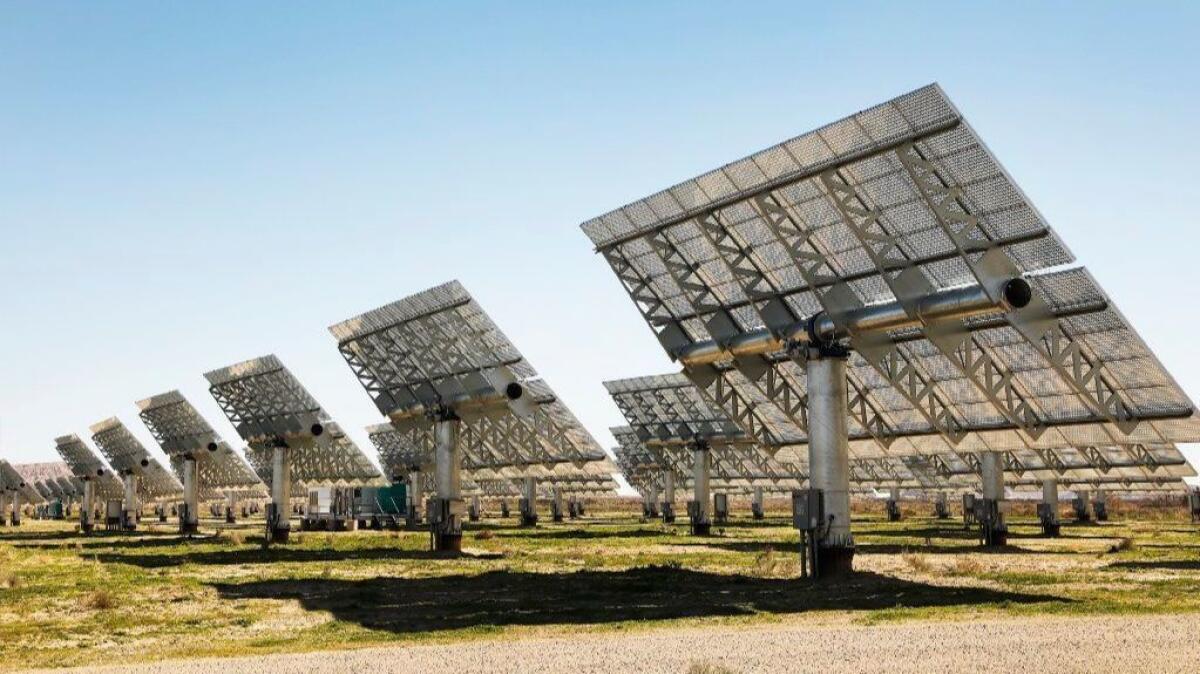
- Share via
To the untrained eye, the shipping containers clustered on the outskirts of Borrego Springs don’t look like an innovative clean-energy technology that could help California cope with wildfires.
But these containers, in the remote desert of eastern San Diego County, are packed with lithium-ion batteries — and they’re part of one of the world’s most advanced microgrids. It combines solar panels, diesel generators, energy storage and something called an ultracapacitor to power Borrego Springs, even when electricity isn’t flowing through the single transmission line that connects the town to the main power grid.
“I believe this is the only microgrid in the world that does what this does,” said Steven Prsha, an engineer for San Diego Gas & Electric Co., as he wrapped up a tour last month.
The technology SDG&E is demonstrating in this rural town could serve as a lifeline to homes and businesses in fire-prone areas.
The state’s biggest investor-owned utilities, Pacific Gas & Electric Co. and Southern California Edison Co., are expected to de-energize power lines more frequently this year to stop them from igniting fires when the weather is dry and windy. It’s one of the fastest and cheapest ways for utilities to keep wildfires from sparking.
But there’s an obvious downside: Whole communities can go dark for hours or even days, preventing residents from cooling homes, refrigerating food and charging phones. If a fire ignites despite the shutoff, the lack of electricity could imperil the work of first responders and complicate evacuation plans.
With those concerns in mind, some energy companies are urging state officials to incentivize microgrids and smaller standalone energy systems, such as rooftop solar paired with batteries, in fire-prone communities. Those technologies, the companies say, could help keep the lights on during preemptive power shutoffs.
At the same time, the typical start of California’s peak fire season is coming in June, and it’s not clear how much support there is among regulators or the state’s biggest utilities for quick action on backup power sources. In their recent wildfire plans, Edison and PG&E had little to say about microgrids and home energy systems for areas facing preemptive power shutoffs. And the California Public Utilities Commission’s safety chief downplayed the potential for microgrids to make a significant difference in the immediate future.
“It doesn’t seem like we have the technical capabilities right now to do systemwide microgrids that can withstand multiday outage events,” said Elizaveta Malashenko, director of the commission’s Safety and Enforcement Division. “Even if that’s where we end up going as a state as a long-term solution, you can’t just plug in a bunch of batteries and [protect] communities in the next six months.”
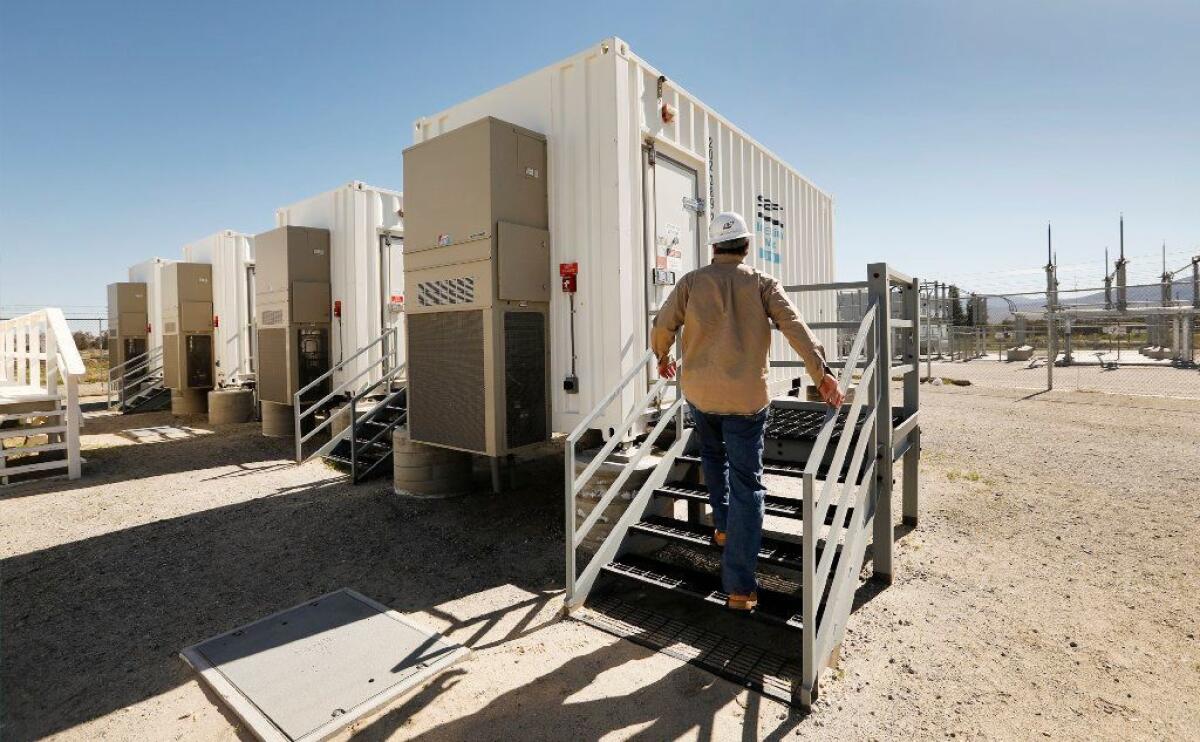
There’s no one definition of microgrid. The term generally refers to an energy system that’s either disconnected from the main grid or can be “islanded” from the grid to keep supplying electricity during an outage.
Microgrids have typically been powered by diesel or other fossil fuels, but they increasingly combine solar power and lithium-ion batteries, especially in places such as California that prioritize clean energy. Navigant Research projects the global microgrid market will grow from $6.3 billion in 2018 to $30.9 billion by 2027.
So far, microgrids have found their biggest opportunities at hospitals, universities and other institutions willing to pay a premium for backup power, as well as places where the grid isn’t reliable. In Puerto Rico, for instance, microgrid installations jumped after Hurricane Maria wrecked the island’s energy infrastructure.
But there’s growing opportunity for the technology in fire-prone California communities facing preemptive power shutoffs, said Peter Asmus, a microgrids expert at Navigant Research. Microgrids are still relatively expensive, but Asmus sees a financial case for them at fire stations, water utilities and emergency shelters.
Microgrids that incorporate solar power and batteries could be especially valuable, Asmus said. Unlike diesel generators, the solar panels will never run out of fuel, and they can recharge the batteries each day.
California set a goal of 100% clean energy, and now other states may follow its lead »
Michael Wara, a Stanford University energy expert, was appointed by Gov. Gavin Newsom to a commission on wildfire costs and utility infrastructure. He thinks microgrids would make it easier for utilities to prevent fires by allowing them to shut down power lines without totally cutting off electricity to critical infrastructure.
Take the Camp fire, which killed at least 85 people and decimated the town of Paradise. In the days leading up to the fire’s ignition in November, PG&E warned 70,000 customers it might shut off power in areas including Paradise. But the utility kept the power on, and it now says its infrastructure probably sparked the blaze.
Installing a microgrid is “not super cheap, but it’s feasible and can be done quickly,” Wara said. “If the benefits are avoiding burning down a community in Northern California, that’s a pretty darn big benefit.”

Something new under the sun
The technology’s potential is on display in the California desert.
Supported by federal and state funding, SDG&E started building the Borrego Springs microgrid in 2012, several years after a wildfire took down the town’s single transmission line and knocked out power for two days. The investor-owned utility, a subsidiary of Sempra Energy, expanded the microgrid after receiving a $5-million grant from the California Energy Commission in 2015.
Today, SDG&E performs a complicated dance in Borrego Springs, coordinating power flow from two diesel generators, a commercial solar farm owned by New Jersey-based Clearway Energy, 4.5 megawatt-hours’ worth of lithium-ion batteries and an armada of solar panels on rooftops throughout the town of 3,500 people — not to mention electricity from the main power grid. SDG&E has “islanded” Borrego Springs during outages, tests and regular maintenance, using the microgrid as the town’s sole power source for several hours at a time.
SDG&E has also installed an ultracapacitor, a sort of super-powerful short-term battery designed to balance rapid shifts in supply and demand, although the utility hasn’t tested it yet. The ultracapacitor was built by San Diego-based Maxwell Technologies, which Elon Musk’s Tesla agreed to acquire for $218 million last month.
Critically, SDG&E’s engineers can operate the microgrid remotely from a control center in Mission Valley, 80 miles away. The utility also partnered with the Colorado-based energy company Spirae to develop advanced microgrid control software, known as Wave, that helps synchronize all the moving pieces.
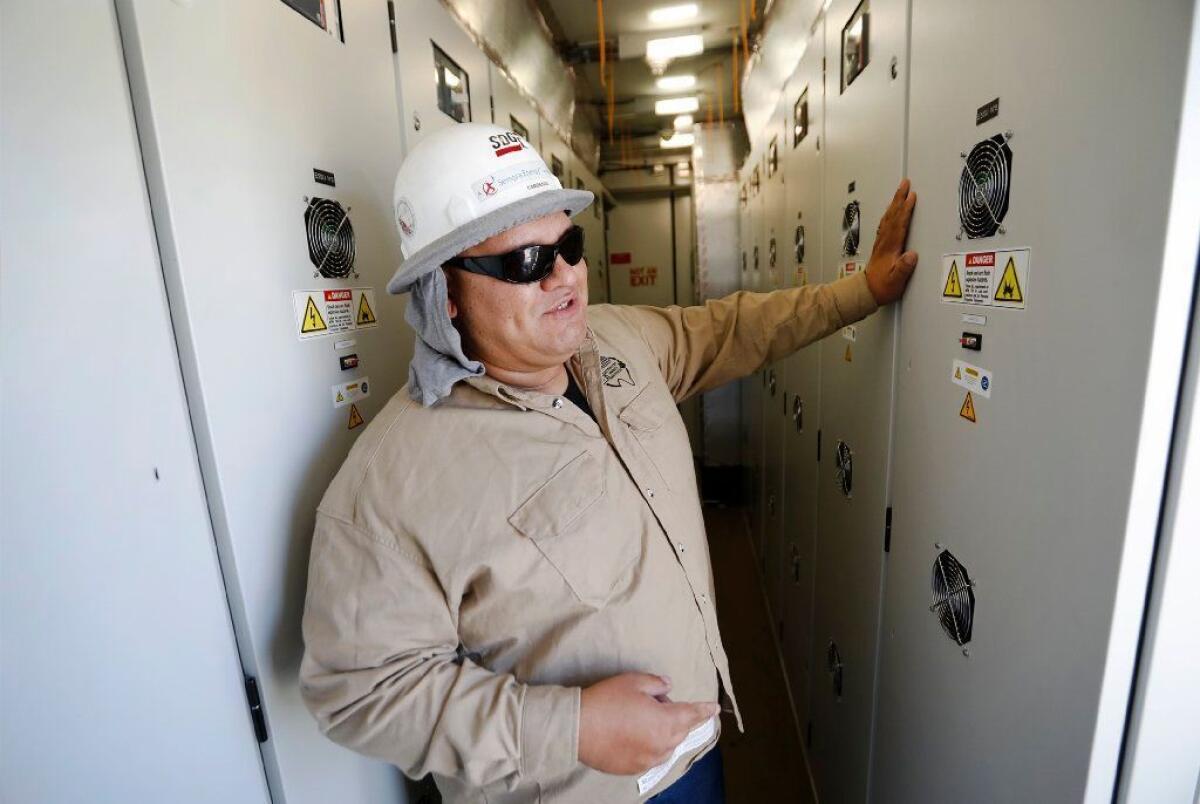
The San Diego utility is still working through some challenges. The company was able to “island” the town using the microgrid for 4½ hours during a planned outage in May, operating the system remotely and keeping the town fully powered with the batteries, diesel generators and Wave software. But a more ambitious test involving the 26-megawatt solar farm didn’t go according to plan, lasting just two minutes.
The diesel generators are the workhorses of the microgrid, said Mike Schneider, SDG&E’s vice president of clean transportation and asset management. He expects that to change as energy storage gets cheaper and SDG&E adds more batteries.
“We want to move toward a carbon-free solution,” Schneider said.
Researchers at the National Renewable Energy Laboratory have studied the microgrid’s capabilities. They say the technology and software being proved out in the desert could benefit California’s more fire-prone areas.
The federally funded research lab, which is based in Golden, Colo., has conducted simulations of how the microgrid and its advanced control software might function during different scenarios. The lessons derived from that research could ultimately be used to help microgrids “island” from the main power grid in areas threatened by wildfires, either during a preemptive power shutoff or during an outage caused by an actual fire.
The research problems are complex, said Martha Symko-Davies, NREL’s laboratory program manager for Energy Systems Integration. But in Borrego Springs, she said, “we haven’t seen any showstoppers.”

‘This is a clear and present danger’
California policymakers have made it clear they want more microgrids.
Last year, the Legislature passed a bill written by state Sen. Henry Stern (D-Canoga Park) that directs regulators and utilities to “facilitate the commercialization of microgrids” that use clean energy. Separately, the California Energy Commission recently awarded $50 million to microgrid demonstration projects.
Some companies say the state should more aggressively support microgrids and other decentralized energy resources, including rooftop solar and storage — especially in areas facing preemptive power shutoffs.
“There’s a lot of focus on what are we going to ultimately do [to prevent wildfires], and not a lot of focus on what are we going to do this summer,” said Tim Hade, a co-founder of Scale Microgrid Solutions. “When you’re taking mortar fire, that’s not the right time to have a strategic conversation about how to prevent mortar fire in the future. You’ve got to do something now, because this is a clear and present danger.”
San Francisco-based Sunrun, one of the country’s largest rooftop solar and battery installers, has encouraged the California Public Utilities Commission to focus on areas facing preemptive power shutoffs as it distributes energy storage incentive funding. The solar-plus-storage systems sold by Sunrun and other firms aren’t exactly microgrids — some people call them “nanogrids” — but they can help homes and businesses keep the lights on during power shutoffs, at least for a few hours each day.
Solar plus storage isn’t cheap. But Anne Hoskins, Sunrun’s chief policy officer, said Californians are already paying the costs of wildfire damage, and will pay more as utilities ramp up their spending to prevent fires.
“Customers are going to be facing really significant rate increases,” Hoskins said. “It’s really a question of what’s the best approach, and to try to take a little bit of a longer view.”
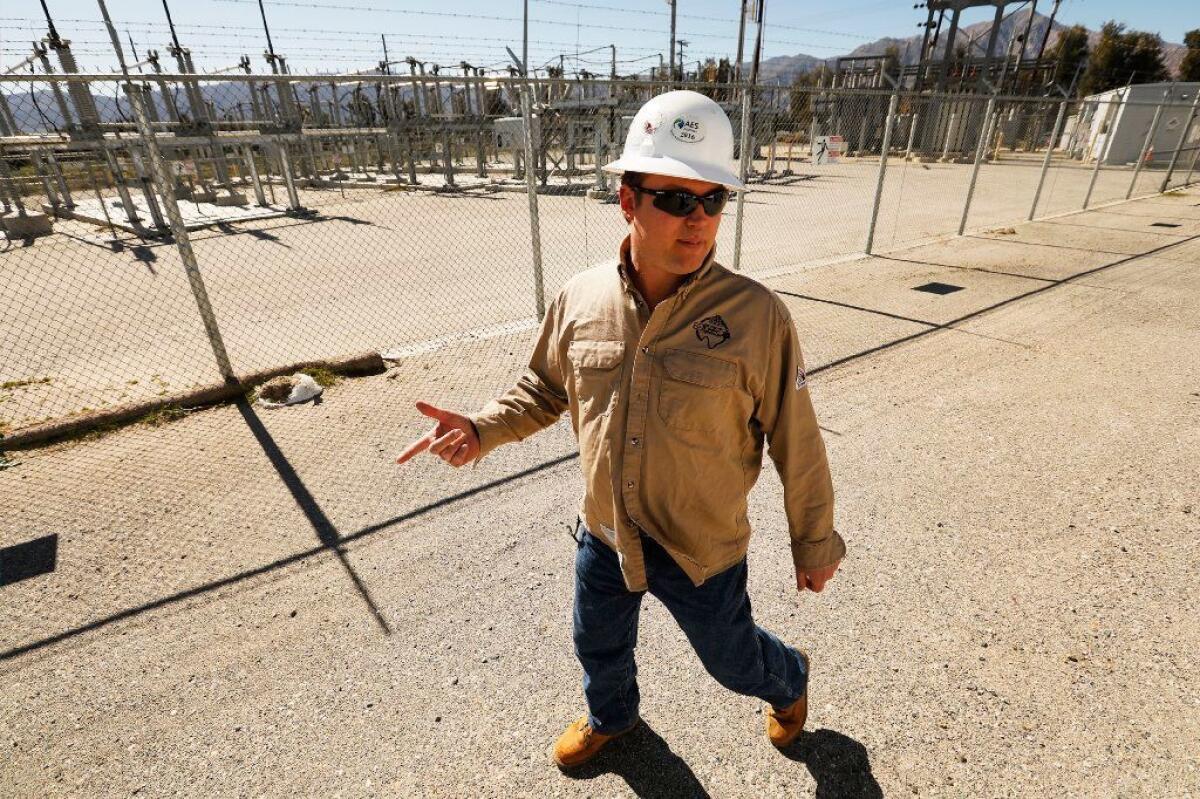
Preventing the power grid from igniting fires is a major focus for the Public Utilities Commission.
Malashenko, director of the commission’s Safety and Enforcement Division, described microgrids and home solar-plus-storage systems as “a tool in the portfolio of tools” for strengthening communities against fires. A key question, she said, is how useful those tools will be in the long term. State officials hope preemptive power shutoffs will become increasingly rare as utilities take other steps to make the power grid safer.
“It would be good to be in a place where proactive power shutoff is not necessary,” Malashenko said.
The utilities commission is looking for ways to minimize the negative effects of Public Safety Power Shutoffs, as preemptive de-energizations are known. While microgrids and home solar-plus-storage systems are part of the conversation, it’s not clear how quickly they could be rolled out on a large scale, Malashenko said.
“It’s not as simple as rolling in a bunch of generation and battery storage and plugging it in,” she said.
Edison doesn’t mention microgrids in its wildfire mitigation plan, although it says it will “consider requests to provide temporary mobile backup generation” to local governments and first responders during an extended outage. Asked about microgrids and wildfires, the company said it is evaluating microgrid technologies and working on new protocols for hooking up microgrids to the main grid, as required by state Sen. Stern’s legislation.
PG&E is working on a “resilience zone” pilot project in the Napa County town of Angwin, where preemptive power shutoffs could occur. In its wildfire mitigation plan, PG&E says it is working with Pacific Union College to build infrastructure, before June 1, that would allow the company to “quickly and safely connect temporary mobile generation” to power the fire station, gas station and student housing.
The utility is also developing a microgrid demonstration project in Arcata, and is “exploring microgrids as an opportunity to quickly and safely provide electric power to areas where a Public Safety Power Shutoff has been initiated or key electric power lines are out of service,” PG&E spokeswoman Lynsey Paulo said in an email.
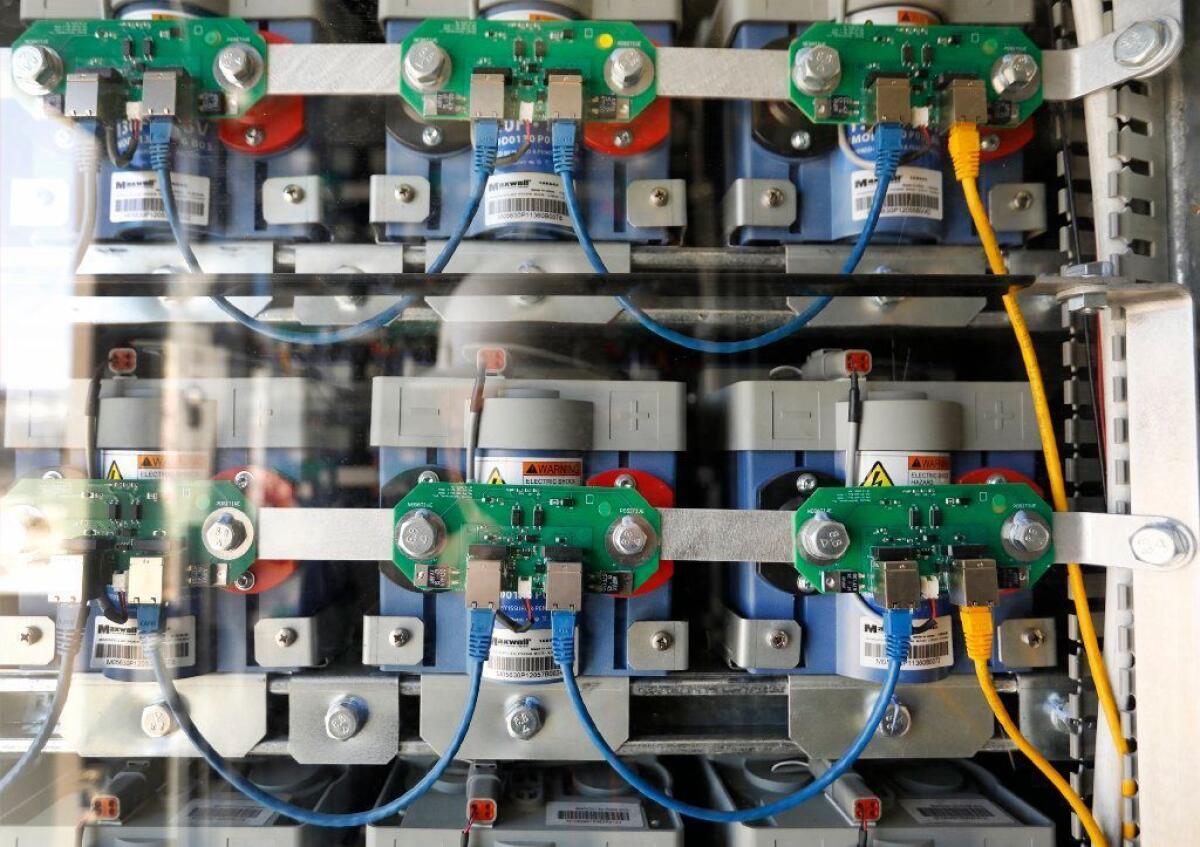
Twitter: @Sammy_Roth
More to Read
Inside the business of entertainment
The Wide Shot brings you news, analysis and insights on everything from streaming wars to production — and what it all means for the future.
You may occasionally receive promotional content from the Los Angeles Times.











